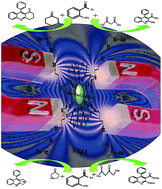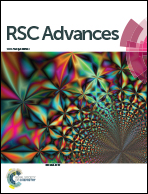Sulfamic acid supported on Fe3O4@SiO2 superpara magnetic nanoparticles as a recyclable heterogeneous catalyst for the synthesis of quinolines
Abstract
In the present study, for the first time the synthesis of sulfamic acid supported on Fe3O4@SiO2 superpara magnetic nanoparticles as a solid acid catalyst with large density of sulfamic acid groups was suggested. The structural and magnetic properties of functionalized Fe3O4@SiO2 nanoparticles are identified by TEM, IR, VSM, XRD, TGA and elemental analysis. Then, the applicability of the synthesized nanoparticles was tested as a recyclable acidic catalyst for the synthesis of quinoline derivatives, an important class of potentially bioactive compounds. The products are obtained in good to high yields (72–98%) from one-pot reaction procedure involving carbonyl compounds and 2-amino benzophenone under solvent-free conditions.


 Please wait while we load your content...
Please wait while we load your content...